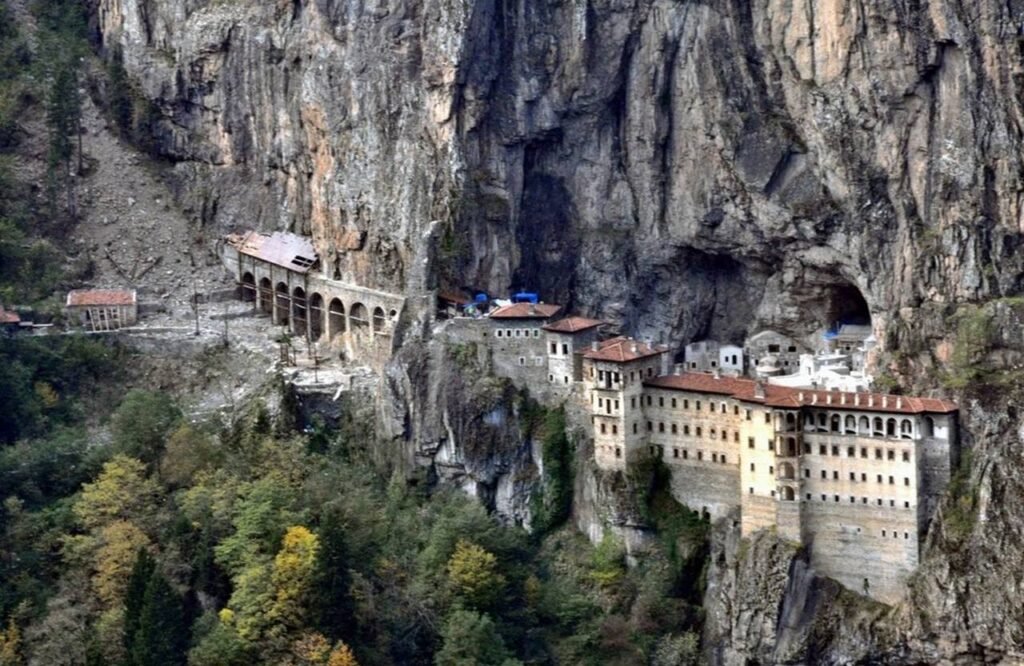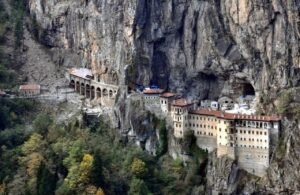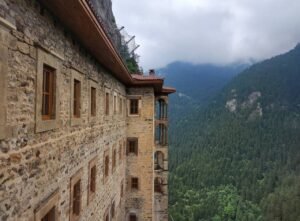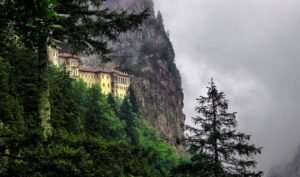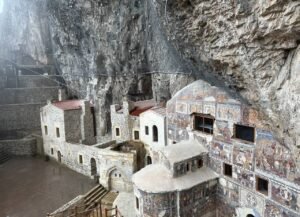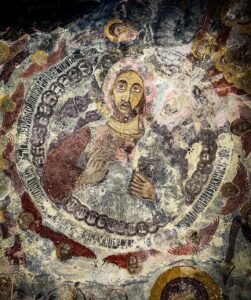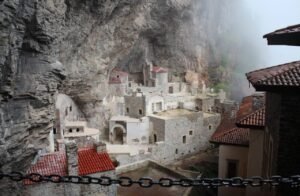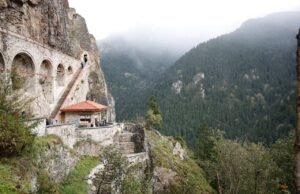Description
Sumela Monastery: A Sacred Marvel in the Cliffs of Trabzon, Türkiye
Nestled dramatically into a sheer cliffside at an altitude of about 1,200 meters (3,900 feet) above sea level, Sumela Monastery is one of Türkiye’s most extraordinary historical and religious landmarks. Located in the lush, forested foothills of the Pontic Mountains, within the boundaries of Altındere Valley National Park in Trabzon Province, this Byzantine-era monastery attracts visitors from around the world for its spiritual history, breathtaking scenery, and architectural wonder.
A Glimpse into History
The origins of Sumela Monastery date back to the 4th century AD, during the reign of the Byzantine Emperor Theodosius I. According to legend, two Athenian monks named Barnabas and Sophronius were guided by a vision of the Virgin Mary to the site, where they discovered an icon of her in a cave. Believing the icon was miraculous, they established the foundations of what would later become the Sumela Monastery.
Over the centuries, the monastery flourished under the patronage of various emperors and sultans. It was particularly important during the Empire of Trebizond (1204–1461), when the site expanded significantly. Following the Ottoman conquest of Trabzon, Sultan Mehmed II, known as Mehmed the Conqueror, allowed the monastery to remain active and even provided funds for its upkeep—highlighting the tolerant policies of the early Ottoman Empire towards Christian institutions.
Architectural Wonder Built Into Nature
What makes Sumela Monastery particularly stunning is its unique location and integration into the natural landscape. Built into a steep rock face above the Altındere River, the monastery appears almost suspended in the air. The journey to reach it includes a winding drive through dense forests followed by a steep climb or, more recently, a shuttle or cable car service that has made access easier.
The complex includes several buildings such as a main rock church, chapels, kitchens, a library, student rooms, and a sacred spring revered for its healing powers. Perhaps the most striking feature is the inner courtyard, which reveals the spectacular frescoes adorning the church walls and ceilings. These frescoes, dating from the 14th to the 18th centuries, depict scenes from the life of Jesus Christ and the Virgin Mary and are considered masterpieces of Byzantine art.
Natural Beauty All Around
The monastery is set within Altındere Valley National Park, a region celebrated for its lush greenery, pristine rivers, and diverse flora and fauna. The setting provides a tranquil and spiritual atmosphere that enhances the overall experience of visiting Sumela. Walking trails and lookout points offer panoramic views of the valley and surrounding mountains, making it a favorite spot for hikers, photographers, and nature lovers.
In spring and summer, the region bursts into vibrant green hues, while autumn blankets the valley in golds and reds. Even winter has its charm, with the snow adding a mystical quality to the already dramatic scenery. No matter the season, the combination of architectural marvel and natural wonder makes a trip to Sumela a memorable one.
Religious and Cultural Significance
For centuries, Sumela was a major pilgrimage site for Orthodox Christians. Although the monastery ceased religious functions after 1923—following the population exchange between Greece and Türkiye—its spiritual importance has endured. Many Greek Orthodox Christians still regard it as a sacred place.
In 2010, after an 88-year hiatus, the Turkish government granted permission for an annual Divine Liturgy to be held at Sumela on August 15th, the Feast of the Dormition of the Virgin Mary. This event draws thousands of pilgrims and symbolizes efforts to promote interfaith understanding and cultural heritage preservation.
Restoration and Modern Access
Due to its age and the harsh climatic conditions of the Pontic Mountains, Sumela Monastery has undergone various restorations over the years. In recent decades, concerns about rockfalls and erosion led to a major restoration project initiated in 2015. The site was closed for several years, during which engineers and conservationists worked to stabilize the cliffs and preserve the monastery’s fragile frescoes.
As of 2020, much of the restoration has been completed, and large sections of the monastery are now open to the public. Enhanced visitor facilities, including a visitor center, shuttle services, and guided tours, make it easier than ever to experience this historical gem. The careful restoration also ensures that Sumela will remain accessible for generations to come.
Getting There
Sumela Monastery is located about 45 kilometers south of Trabzon, a bustling Black Sea port city that serves as a major transportation hub in the region. Visitors can fly into Trabzon Airport, which has frequent domestic flights from Istanbul, Ankara, and other major Turkish cities.
From Trabzon, you can rent a car or join a guided tour that includes transportation to the monastery. For those seeking a more immersive experience, day trips often include stops at other nearby attractions such as Uzungöl Lake, Zagnos Valley, and Trabzon’s Hagia Sophia Museum.
Tips for Visitors
-
Best Time to Visit: Late spring through early autumn (May–October) offers the most comfortable weather and clearest views.
-
Dress Appropriately: While the monastery is now primarily a museum, modest dress is recommended out of respect for its religious heritage.
-
Plan for Walking: Wear comfortable shoes for the uphill walk, although shuttle and cable car options are available.
-
Photography: Flash photography is not allowed inside the frescoed areas to protect the delicate paintings.
-
Bring Water: Facilities are available, but it’s always wise to carry a bottle of water, especially during the climb.
A Place Where Time Stands Still
Sumela Monastery is more than a tourist destination—it’s a testament to centuries of faith, resilience, and artistic expression. Whether you're drawn by its religious history, architectural ingenuity, or stunning natural setting, visiting Sumela is a journey that touches the soul. As you stand in its shadowed courtyards, with the sound of wind echoing through the cliffs, you’ll understand why this monastery has fascinated travelers and pilgrims for over 1,600 years.
Location
-
Altindere Valley National Park, Altındere, 61750 Maçka/Trabzon
